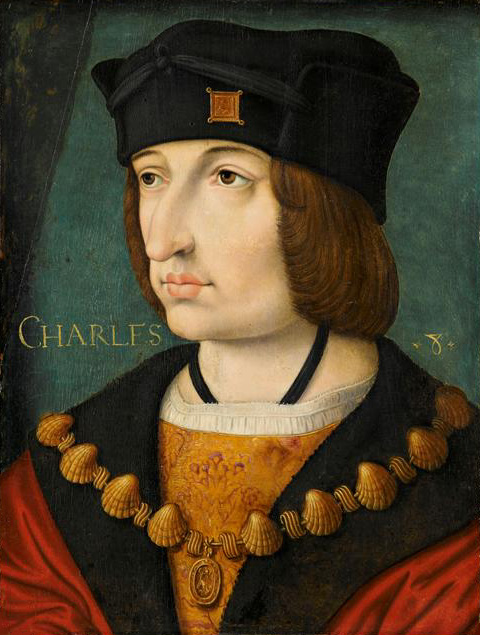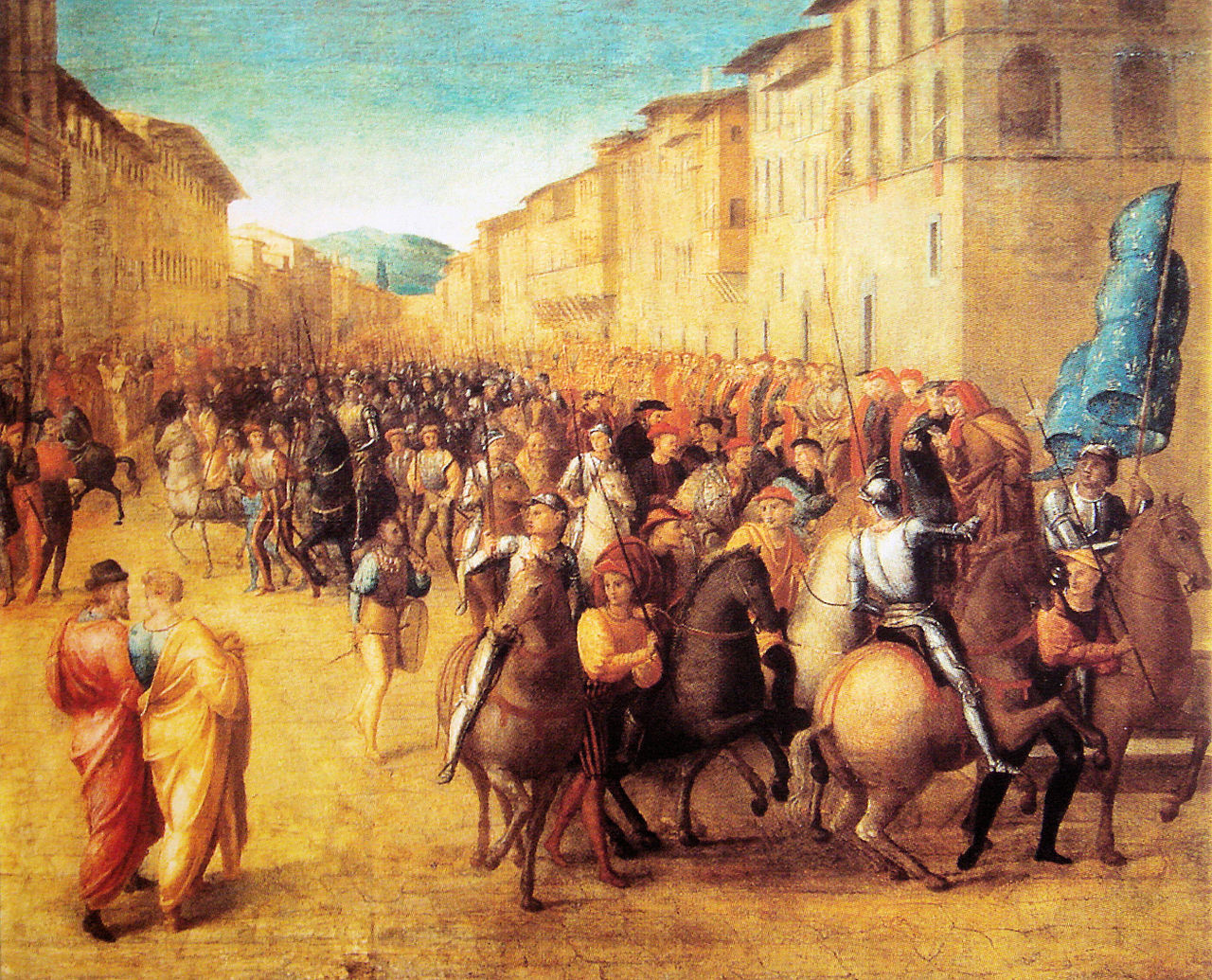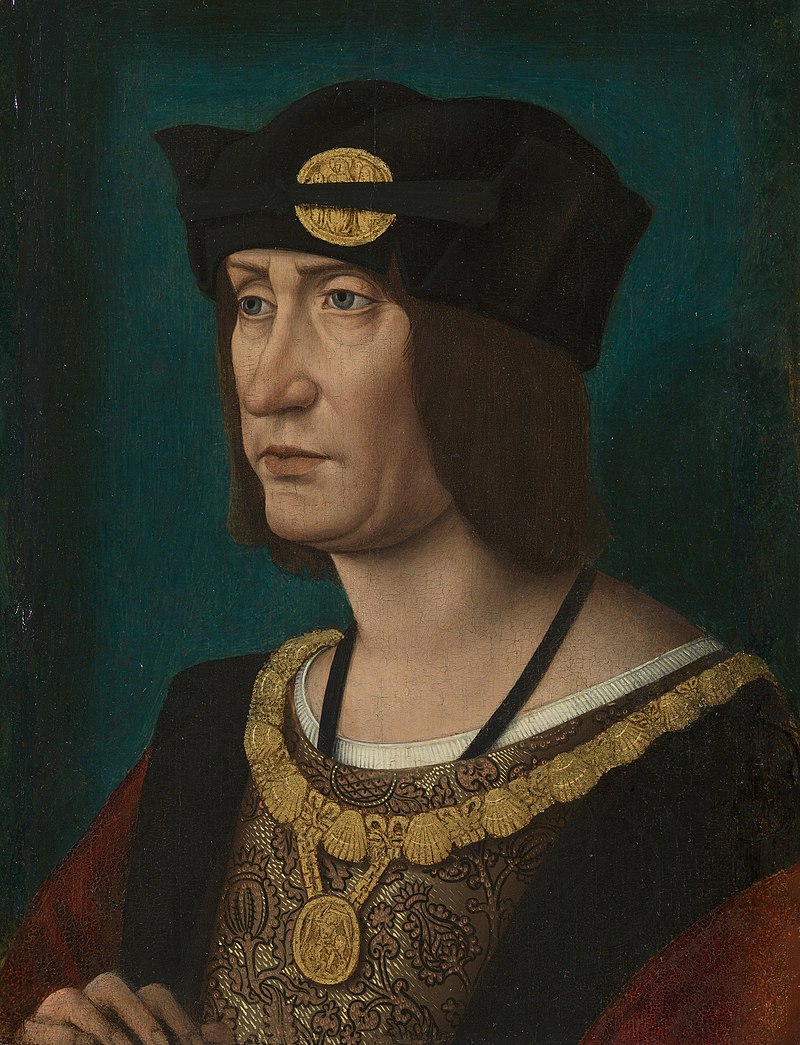by Susan Flantzer © Unofficial Royalty 2020

Charles VIII, King of France; Credit – Wikipedia
King Charles VIII of France was born at the Château d’Amboise in France on June 30, 1470. He was the seventh of the eight children and the fourth and the only surviving son of the five sons of King Louis XI of France and his second wife Charlotte of Savoy. Out of his parents’ eight children, only Charles and his sisters Anne and Jeanne survived childhood. Charles’ father had no children from his first marriage to Margaret of Scotland, daughter of James I, King of Scots.
- Louis (1458 – 1460)
- Joachim (born and died 1459)
- Louise (born and died 1460)
- Anne of France (1461 – 1522), married Peter II, Duke of Bourbon, had two children
- Jeanne of France (1464 – 1505), married King Louis XII of France (first of three wives), no children, marriage annulled, founded the monastic Order of the Sisters of the Annunciation of Mary, canonized as a saint in 1950
- François ( born and died 1466)
- François, Duke of Berry (1472 – 1473)

King Louis XI of France; Credit- Wikipedia
Since Charles was his father’s only surviving son and was often ill, his father Louis XI, was more concerned with his health than his education. Accordingly, Charles’ education was less rigorous than it normally would have been. The study of Latin was eliminated, although Louis XI had first studied Latin at the age of six. Charles was given a humanist tutor, Guillaume Tardif. Tardif ordered simplified treatises written for Charles and read them to him. One such treatise was on the Wars of the Roses, which was occurring at the time in England.
In 1475, the Treaty of Picquigny between King Edward IV and the Kingdom of England and King Louis XI and the Kingdom of France ended the Hundred Years War. One of the agreements was that five-year-old Charles would marry nine-year Elizabeth of York, the eldest child of King Edward IV of England. That arrangement did not come to fruition, and Elizabeth of York eventually married King Henry VII, the first Tudor monarch.
Next, Louis XI tried to make two Burgundian marriages for his only son, Charles. After the death of Charles the Bold, Duke of Burgundy in 1477, Louis XI had plans to take over the guardianship of Charles the Bold’s only child Mary, Duchess of Burgundy, in her own right. He planned to marry his seven-year-old son Charles to the twenty-year-old Mary and reunite Burgundy with France. However, Mary was of legal age, the sovereign ruler of the Duchy of Burgundy, and decided to marry Archduke Maximilian of Austria, later Maximilian I, Holy Roman Emperor.

Archduchess Margaret of Austria; Credit – Wikipedia
In 1482, 25-year-old Mary, Duchess of Burgundy died of internal injuries following a severe fall from her horse. France and Burgundy had been at war over land, and Mary’s widower decided to settle the situation. The Treaty of Arras ended the dispute. Mary’s two-year-old daughter, Archduchess Margaret of Austria, would marry Louis XI’s son Charles. The Imperial County of Burgundy, west of the Duchy of Burgundy, would come to the French crown as part of Margaret’s dowry. Charles and Margaret were betrothed in 1483, and Margaret’s guardianship was transferred to King Louis XI of France. She was to be raised in France as a fille de France (daughter of France) and prepared for her future role as Queen of France. However, within months of the betrothal, King Louis XI died and his thirteen-year-old son became King Charles VIII of France. The coronation of King Charles VIII took place on May 30, 1484, in Notre-Dame Cathedral in Reims, France, the traditional site for the coronation of the Kings of France.
Under Louis XI’s will, his daughter Anne and her husband, Peter II, Duke of Bourbon, ruled as regents until 1491. Margaret of Austria remained in France, where she continued to be educated and prepared for her future role as Charles’ wife and Queen of France. However, the sudden death of François II, Duke of Brittany, due to a fall from his horse, on September 9, 1488, changed the situation. François II had only two surviving children, both daughters, and the elder daughter succeeded him as Anne, Duchess of Brittany in her own right. Fearing for the independence of her duchy against the might of France, Anne arranged a marriage for herself with Archduke Maximilian of Austria, the widower of Mary, Duchess of Burgundy, in her own right.

Anne, Duchess of Brittany at prayer surrounded by Saint Anne, Saint Ursula, and Saint Helena by Jean Bourdichon; Credit – Wikipedia
Anne of France and her husband, Peter II, Duke of Bourbon, the regents of France, refused to allow a marriage between Anne of Brittany and Maximilian of Austria because it would put the Habsburgs, Maximilian’s family, on two French borders. A month before Anne of Brittany’s father died, he had been forced to sign the Treaty of Verger, thereby becoming a vassal of King Charles VIII of France and agreeing to seek Charles’ consent before arranging the marriage of his daughters. The Treaty of Verger was used to force Anne to renounce Archduke Maximilian of Austria, whom she had married by proxy, and marry King Charles VIII of France. Likewise, Margaret of Austria was also jilted, and she resented the House of Valois for the rest of her life. However, Margaret became one of the greatest government administrators, political negotiators, and patrons of her time. She served her nephew Charles V, Holy Roman Emperor as Governor of the Habsburg Netherlands.

Waxwork reenactment of the marriage of Anne, Duchess of Brittany and King Charles VIII of France; Credit – Wikipedia
Anne, Duchess of Brittany and King Charles VIII of France were married at the Château de Langeais on December 6, 1491. On February 8, 1492, Anne was crowned Queen of France at the Basilica of Saint-Denis near Paris, France.
Anne and Charles had seven children, but none survived:
- Charles Orlando, Dauphin of France (1492 – 1495), died from measles at the age of three
- François (stillborn 1493)
- Stillborn daughter (1494)
- Stillborn daughter (1495)
- Charles, Dauphin of France (September 1496 – October 1496)
- François, Dauphin of France (1497), died several hours after birth
- Anne of France (1498), died several hours after birth

French troops under Charles VIII entering Florence, November 17, 1494, by Francesco Granacci; Credit – Wikipedia
The main event of Charles VIII’s reign was the Italian War of 1494–1498, fought against the Holy Roman Empire, Spain, and an alliance of Italian powers led by Pope Alexander VI. Charles made a series of concessions to neighboring monarchs and conquered Italy without much opposition. However, a coalition of armies ultimately drove out Charles’ army.
On March 20, 1498, Queen Anne gave birth to a daughter at the Château d’Amboise, who died on the day of her birth. To distract her from her sadness, on April 7, 1498, Charles took Anne to watch a game of jeu de paume (real tennis). As they were walking to the tennis court at the Château d’Amboise, Charles violently hit his head on a stone lintel of a low door. He stumbled but did not lose consciousness and proceeded to the tennis court where he watched the game. At around two o’clock in the afternoon, Charles suddenly collapsed, fell into a coma, and died nine hours later at the age of 27. Modern medical experts suspect that Charles died from a head trauma that led to a stroke with a subdural hematoma and neurological damage.
King Charles VIII had a grand funeral. The services lasted until May 1, 1498, when the tomb was closed. He was buried at the Basilica of Saint-Denis near Paris, France, but his heart was buried at the Basilica of Notre-Dame de Cléry in Cléry-Saint-André, France, so he could be near his parents’ tomb. Charles VIII’s tomb was one of the most beautiful tombs at the Basilica of Saint-Denis. It was quite large and made of gilded bronze and enamel. The enameled statue of Charles VIII showed him praying, wearing a blue robe with fleur-de-lis (lily flowers). At the four corners were bronze angels, and around the base were female figures in medallions. During the French Revolution, Charles’ tomb was destroyed, and the materials were melted down.

Tomb of Charles VIII; Credit – Wikipedia
Because King Charles VIII had no surviving sons (nor daughters), he was succeeded by his second cousin once removed Louis II, Duke of Orléans as King Louis XII of France. Louis XII’s father Charles I, Duke of Orléans was the grandson of King Charles V of France through his second son, Louis I, Duke of Orléans. In 1476, the future Louis XII married Jeanne of France, daughter of King Louis XI of France and sister of King Charles VIII. Charles VIII’s widow, Anne, returned to her Duchy of Brittany after his death and began taking steps to ensure her duchy’s independence. Louis XII did not want this to happen, so he annulled his 24-year childless marriage to Charles VIII’s sister Jeanne of France. Once more, Anne of Brittany, had the Treaty of Verger used against her, as Louis XII, as King of France, had to consent to her marriage. She was forced to agree to marry King Louis XII.

King Louis XII of France; Credit – Wikipedia
On January 7, 1499, Louis XII married Anne, Duchess of Brittany, in Nantes, Duchy of Brittany, now in France. Louis XII never did get his male heir. Anne and Louis had four stillborn sons and three miscarriages, but they did have two daughters who survived to adulthood. Weakened by sixteen pregnancies in twenty years, 36-year-old Anne, twice Queen of France, Duchess of Brittany, died from a kidney stone attack on January 9, 1514. After Anne’s death, the 52-year-old Louis XII, still seeking a son to succeed him, married 18-year-old Mary Tudor, the younger sister of King Henry VIII of England, but Louis XIII died three months after the marriage, without a male heir.
This article is the intellectual property of Unofficial Royalty and is NOT TO BE COPIED, EDITED, OR POSTED IN ANY FORM ON ANOTHER WEBSITE under any circumstances. It is permissible to use a link that directs to Unofficial Royalty.
France Resources at Unofficial Royalty
Works Cited
- En.wikipedia.org. 2020. Charles VIII of France. [online] Available at: <https://en.wikipedia.org/wiki/Charles_VIII_of_France> [Accessed 11 June 2020].
- En.wikipedia.org. 2020. Louis XI of France. [online] Available at: <https://en.wikipedia.org/wiki/Louis_XI_of_France> [Accessed 1 June 2020].
- Flantzer, Susan, 2020. Anne, Duchess of Brittany, Queen of France. [online] Unofficial Royalty. Available at: <https://www.unofficialroyalty.com/anne-duchess-of-brittany-queen-of-france/> [Accessed 11 June 2020].
- Fr.wikipedia.org. 2020. Charles VIII (Roi De France). [online] Available at: <https://fr.wikipedia.org/wiki/Charles_VIII_(roi_de_France)> [Accessed 11 June 2020].
- Fr.wikipedia.org. 2020. Louis XI. [online] Available at: <https://fr.wikipedia.org/wiki/Louis_XI> [Accessed 11 June 2020].
- McMahon, Emily and Flantzer, Susan. 2013. Louis XII, King of France. [online] Unofficial Royalty. Available at: <https://www.unofficialroyalty.com/june-27-daily-featured-royal-date/> [Accessed 1 June 2020].
